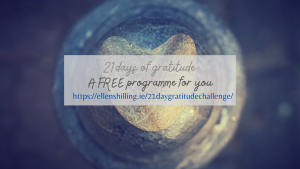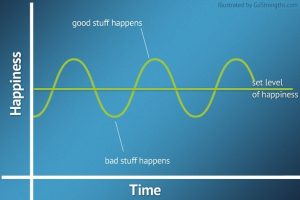

Psychologists talk about your happiness set point. Is it described as a level of happiness that you operate at and when good stuff happens (like you win the lotto), your happiness increases (naturally) but over time you return to this set point. Likewise when bad stuff happens (like you lose your job), your happiness is adversely affected but over time you will eventually reset to this base line. The higher that your base line is the more you are able to adapt and cope with both the good stuff and the bad stuff in life.
Psychologists and Neuroscientists thought that this natural tendency or base line of happiness could not be changed. They believed that it was ingrained in your brain, inherited via your family and set by your environment. They thought that there was nothing you could do to move it; you were born either as a naturally happy, optimistic person, a dour, pessimist or somewhere in between.
The good news!
Until recently, when an innovative scientific research project looked at the brain and a phenomenon that was being talked about called neuroplasticity: a hypotheses that suggested that the brain was plastic and could be moulded and remoulded. The scientists selected a group of people who had never meditated before and taught them mindfulness. The participants practiced every day over a number of months and brain scans we taken before they began the experiment, at regular points during the course of the experiment and at the end. What it proved them, much to their shock (and in black and white) was how the brains of all the meditators had changed shape and their happiness set points had all elevated.
This has astounded the scientific community as they realised that the brain is malleable and not fixed as they thought. They saw that you can strengthen different areas of the brain. For example, If you practice being hard on yourself(which most of us practice probably every day at least if not every hour) then that region of the brain gets more use and like going to a gym, the “muscle” of self-criticism gets stronger and so appears more often in your thinking, behaviour and decisions.
Also, if you practice self-compassion and patience then that area also becomes stimulated and over time, with practice, that “muscle” becomes stronger and you’re thinking, behaviours and decisions automatically start to become more self compassionate and patient. Naturally. Without any effort as such. Your happiness set point increases and your overall well-being improves.
So how can you improve your own happiness set point? Lots of people think that lots of things make them happy such as shopping, a good night out, a holiday, a promotion etc and while all these things are good for our happiness in a moment, they’ve been shown not to contribute to our lasting happiness. If you want lasting happiness an amount of work is required. Much like going to the gym: you’ll get out of it whatever you put into it, and there are some practices that are better than others.
The two best happiness increasing practices are:
1. Mindfulness. It’s really the most effective and direct way to increase your happiness and it’s been scientifically proven. There are free apps you can try such as headspace, calm or insight timer ideally though sign up to a local class. “Mindfulness is a way to live your life as if it really matters.” John Kabat Zinn
2. Gratitude. Research shows that consistently grateful people are happier, more energetic, more hopeful, more helpful, more empathic, more spiritual, more forgiving, and less materialistic. They’re also less likely to be depressed, anxious, lonely, envious, neurotic, or sick.
It has also been shown that with regular practice, your brain neurons will automatically look for more things to be grateful for in your life….you literally become re-wired to be happier!
Lisa Rankin :
“50% of our propensity for happiness is based on a genetic set point, something we can’t influence very much, 10% is based on life circumstances (such as getting the promotion, finding The One, or achieving the creative dream), and 40% is “intentional activity” that we can influence with our behavior.
That means we can be up to 40% happier in our lives without changing our circumstances one bit, and one of the key intentional activities is the practice of gratitude.”
How do you practise gratitude?
Well I have put a free programme together for you called the 21 days of gratitude…..and you can have a look at what the programme will bring you, just click on the button below